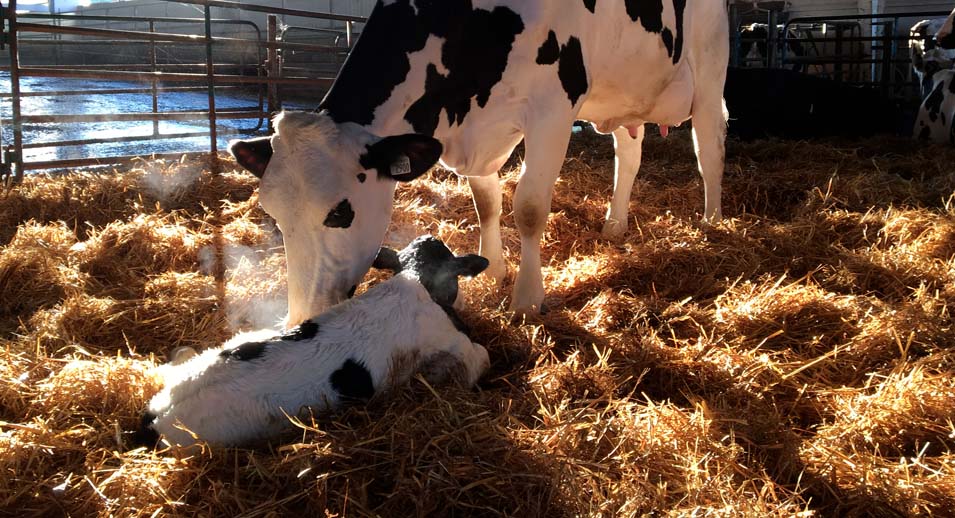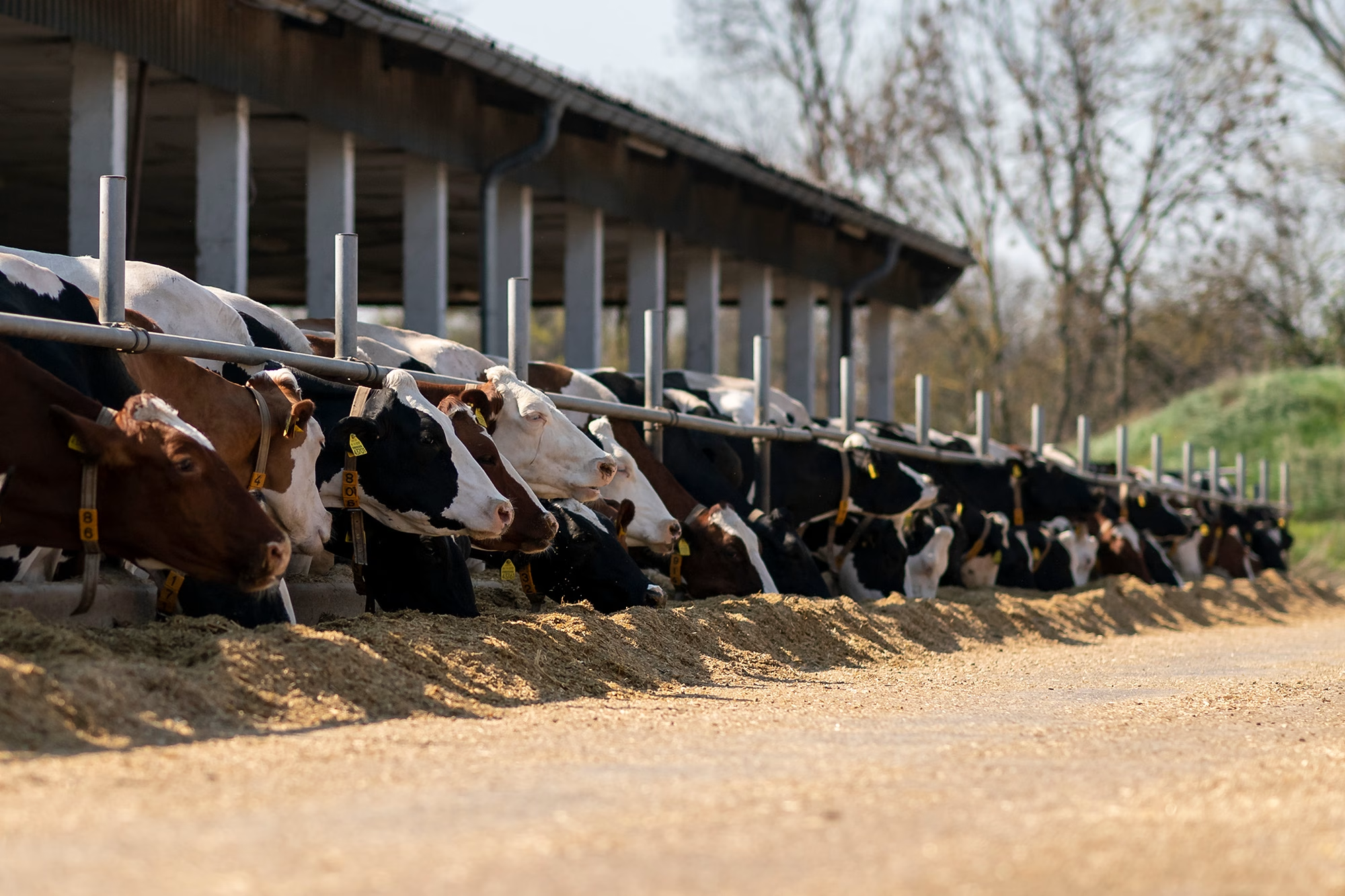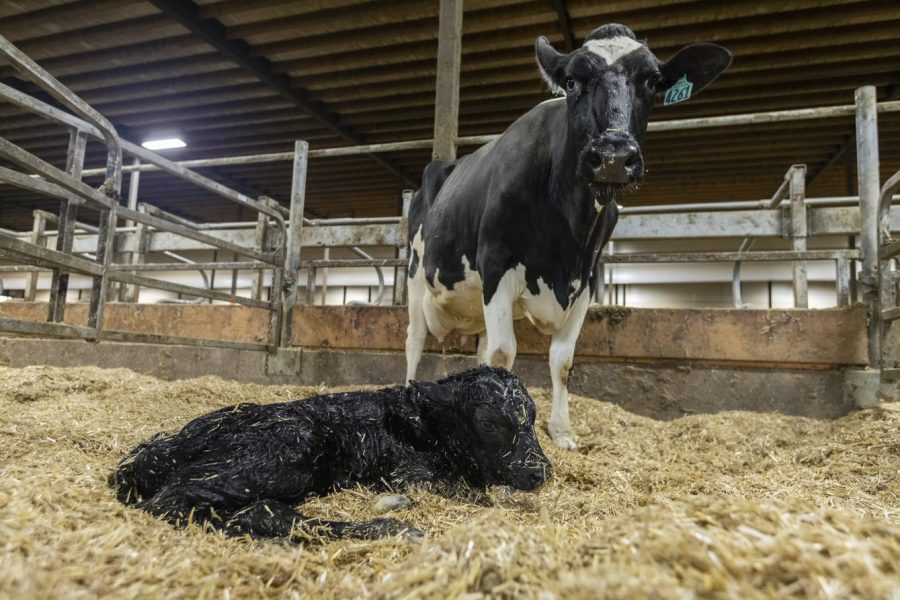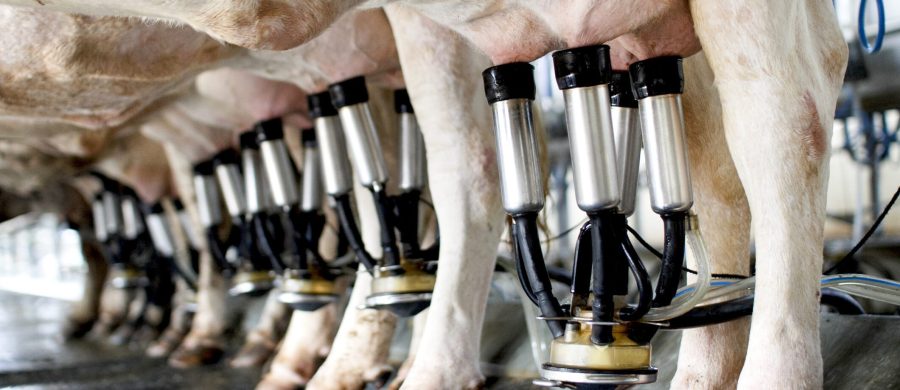Find out how pre-calving body condition affects dairy cows‘ health and milk yield. Are your cows ready for peak production? Please read our latest article to learn more.

If you’ve ever wondered why some cows produce more milk than others, the answer might be their body condition score (BCS) before calving. A new University of Florida, research of 427 multiparous Holstein cows, emphasizes the relevance of prepartum BCS. The study discovered that a moderate prepartum BCS (3.25-3.75) improves dry matter intake (DMI), energy balance (EB), and milk supply – The Goldilocks Principle. Cows with a moderate BCS ingested more dry matter and had a better energy balance, increasing milk production. For dairy producers, this data may help you improve herd performance and profitability by enhancing your cows’ prepartum BCS.
The Critical Role of Body Condition Score in Dairy Cow Management
The Body Condition Score (BCS) is an essential metric dairy producers use to determine how much fat a cow has on its body. This evaluation helps to define a cow’s health, nutritional state, and general well-being. BCS is usually assessed on a scale of one to five, with one suggesting malnourished cows and five indicating obese ones. Here’s a closer look at how BCS is determined and its significance:
- How BCS is Measured: Farmers often use a visual and tactile assessment to measure BCS. This involves observing and feeling specific areas of the cow’s body, such as the loin, ribs, and tailhead. Tools like portable ultrasound backfat instruments can also provide a more precise measurement.
- Categories of BCS:
- Fat (BCS ≥ 4.00): These cows have excess body fat, which can negatively impact dry matter intake (DMI) and energy balance (EB).
- Moderate (BCS = 3.25–3.75): Ideally, these cows have balanced body fat, promoting optimal health and productivity. They are less prone to metabolic issues postpartum.
- Thin (BCS ≤ 3.00): Cows with low body fat may struggle with energy reserves, affecting their ability to maintain milk production and overall health.
Maintaining the correct BCS, especially before calving, is crucial for several reasons:
- Energy Balance: Cows with a moderate BCS generally have a better energy balance pre- and postpartum, which supports higher milk yield.
- Health and Longevity: Proper BCS reduces the risk of metabolic disorders and enhances the cow’s overall health, leading to greater longevity in the herd.
- Reproductive Performance: Cows with an appropriate BCS have better reproductive performance, vital for maintaining an efficient and productive dairy operation.
Monitoring BCS is critical for dairy producers to guarantee their cows’ maximum health and output. Regular examinations and dietary modifications based on BCS may considerably enhance cow outcomes and dairy farm performance.
Optimizing Nutritional Intake and Energy Balance Through Prepartum Body Condition Score Management
| Body Condition Score Category | Dry Matter Intake (kg/d) | Energy Balance (Mcal/d) |
|---|---|---|
| Fat (BCS ≥ 4.00) | 9.97 ± 0.21 | -4.16 ± 0.61 |
| Moderate (BCS = 3.25–3.75) | 11.15 ± 0.14 | -1.20 ± 0.56 |
| Thin (BCS ≤ 3.00) | 11.92 ± 0.22 | 0.88 ± 0.62 |
When examining the prepartum phase, the association between Body Condition Score (BCS) and both Dry Matter Intake (DMI) and Energy Balance (EB) provides essential information for dairy management. Higher fat BCS (≥ 4.00) corresponds with lower DMI before calving, perhaps leading to nutritional shortfall. These cows had a prepartum DMI of about 9.97 kg/day. Cows with an intermediate BCS (3.25–3.75) had a more balanced intake of 11.15 kg/day, whereas skinny cows (≤ 3.00) had the greatest DMI of 11.92 kg/day. This variation in feed intake has a considerable influence on EB, with obese cows suffering the most significant negative energy balance (-4.16 Mcal/day), moderate cows sustaining a less severe deficit (-1.20 Mcal/day), and thin cows obtaining a nearly neutral balance (0.88 Mcal/day). These data highlight the need to keep cows at a moderate BCS prepartum to maximize their nutrition and energy condition, resulting in improved health and production after calving.
Postpartum Nutritional Challenges Tied Directly to Prepartum Body Condition
| Body Condition Score | Postpartum Dry Matter Intake (kg/day) | Postpartum Energy Balance (Mcal/day) |
|---|---|---|
| Fat (≥ 4.00) | 14.35 ± 0.49 | -12.77 ± 0.50 |
| Moderate (3.25–3.75) | 15.47 ± 0.38 | -10.13 ± 0.29 |
| Thin (≤ 3.00) | 16.09 ± 0.47 | -6.14 ± 0.51 |
Prepartum body condition score (BCS) has a significant impact on postpartum dry matter intake (DMI) and energy balance (EB), with striking disparities reported between cows of different BCS categories after calving. When cows were categorized as fat, moderate, or thin, the fat cows had the lowest DMI postpartum, eating an average of 14.35 kg/day, compared to 15.47 kg/day for moderate cows and 16.09 kg/day for thin cows.
The ramifications of these differences are enormous. Fat cows had a decreased feed intake and a considerably negative EB, with an average deficit of -12.77 Mcal/day. This starkly contrasts intermediate cows (-10.13 Mcal/day) and lean cows (-6.14 Mcal/day). This negative EB in more giant cows underlines a vital issue: excessive prepartum BCS may significantly limit postpartum feed intake and energy balance, affecting overall health and production.
While skinny cows had the greatest postpartum DMI and the lowest negative EB, suggesting improved nutritional adaptation after calving, obese cows suffered the most. Moderate BCS cows, conversely, struck a compromise, achieving appropriate feed intake while maintaining tolerable EB deficits directly related to better lactations and increased milk supply.
Balancing Act: The Quadratic Impact of Prepartum Body Condition Score on Milk Yield
| Body Condition Score (BCS) | Daily Milk Yield (kg) | 28 Day Cumulative Milk Yield (kg) |
|---|---|---|
| 2.5 to 3.0 | Increased by 6.0 kg | 147 kg more |
| 3.5 to 4.0 | Decreased by 4.4 kg | 116 kg less |
Analyzing the link between prepartum body condition score (BCS) and milk production indicates a complex quadratic relationship. The research found a significant boost in milk production with a modest rise in prepartum BCS from 2.5 to 3.5. This increase was related to a considerable increase in daily milk supply, improving lactation performance by 6.0 kg per day and resulting in a staggering 28-day total milk gain of 147 kg. However, this favorable tendency reverses when prepartum BCS rises from 3.5 to 4.5. In such cases, milk output starts to fall, as demonstrated by a 4.4 kg drop in daily yield and a 116 kg loss during the first 28 days post-calving. These findings highlight the need to maintain a moderate BCS in the range of 3.25 to 3.75 before calving to improve milk supply while avoiding the double-edged sword of an elevated condition score, which ultimately impedes lactation results.
The Goldilocks Principle: Striking the Perfect Balance with Pre-Calving BCS for Optimal Milk Yield
| Body Condition Score (BCS) | Outcome on Lactation |
|---|---|
| ≤ 3.0 (Thin) | Lower DMI, lower energy balance, suboptimal milk yield |
| 3.25 – 3.75 (Moderate) | Optimal DMI, balanced energy levels, higher milk yield |
| ≥ 4.0 (Fat) | Lower DMI, negative energy balance, reduced milk yield |
Dairy cows’ milk output is closely related to their body condition score (BCS) before calving. The researchers discovered a quadratic association between prepartum BCS and subsequent milk output. As BCS climbs from 2.5 to 3.5, milk output improves significantly, with a daily milk yield gain of 6.0 kg and a total 28-day milk yield boost of 147 kg. This highlights the necessity of maintaining an appropriate BCS to increase output. Pushing BCS above this ideal range (3.5 to 4.5) reduces milk output by 4.4 kg per day and 116 kg per 28 days. This decline is most likely caused by excessive fat storage, which impairs metabolic efficiency and general health and negatively influences milk supply. As a result, dairy producers who want to maximize milk output while protecting their herds’ health and well-being must strive for a moderate prepartum BCS (preferably between 3.25 and 3.75).
The Goldilocks Principle: Striking the Perfect Balance with Pre-Calving BCS for Optimal Milk Yield
Maintaining cows in the moderate BCS range is essential for optimizing milk yield and ensuring cows’ overall health. Here are some practical tips to help you effectively monitor and manage BCS in your herds:
- Regular BCS Assessments: Schedule routine BCS evaluations every two weeks through the transition period. Utilize a standardized scoring system to ensure consistency. Engage trained personnel with practical experience in academic and commercial settings to conduct these assessments, as accuracy is crucial.
- Balanced Nutrition: Ensure your cows’ diet is formulated to meet their nutritional needs without overfeeding energy-dense feeds. Aim for a diet that supports moderate BCS (3.25 to 3.75). If a cow’s BCS falls below 3.0, increase energy intake through quality forage and concentrates.
- Strategic Feeding: Implement a feeding strategy that caters to cows’ dietary needs at different stages. For prepartum cows, provide easily digestible, high-fiber feeds to promote a steady increase in dry matter intake (DMI). Postpartum cows require a high-energy, high-protein diet to support weight maintenance and milk production.
- Monitor Dry Matter Intake (DMI): Record the daily DMI to evaluate nutritional intake accurately. Low DMI can be a sign of overfeeding energy prepartum, leading to postpartum complications, including lower milk yield and poor energy balance.
- Adjust Feeding Practices: If cows show signs of becoming excessively fat (BCS>3.75), reduce their energy intake by adjusting the concentrate levels. Conversely, thinner cows (BCS<3.0) may require supplemental feeding with energy-rich diets to bring them within the moderate range.
- Stress Management: Mitigate stress factors such as overcrowding, abrupt dietary changes, and poor housing conditions. Stress can adversely affect feed intake and, consequently, BCS.
- Consult a Nutritionist: Work with a dairy nutritionist to design and periodically review ration formulations. A nutritionist can provide insights into balancing forages, grains, and supplements for different cow groups based on their BCS and production stage.
By closely monitoring and managing BCS through tailored nutrition and feeding strategies, you can help your cows maintain optimal health and productivity and ensure a successful lactation period.
The Bottom Line
Maintaining a moderate body condition score (BCS) three weeks before calving is critical for maximum milk output and herd health. This balance improves dry matter intake (DMI) and energy balance (EB), affecting productivity and well-being. Cows with a moderate BCS (3.25 to 3.75) produce more milk than thinner and fatter cows and have fewer health risks. Cows in this range have better dietary habits, higher energy balance, and fewer postpartum illnesses. Dairy producers should emphasize frequent BCS monitoring before calving. Precise feeding and evaluations may help increase milk supply and herd health. They are keeping cows in the ‘Goldilocks zone’ of moderate BCS results in a healthier, more productive dairy farm. Let us keep our cows healthy and sustain our livelihoods.
Key Takeaways:
- Prepartum Body Condition Score (BCS) has a significant impact on both prepartum and postpartum Dry Matter Intake (DMI) and Energy Balance (EB).
- Cows with a moderate BCS at 21 days before calving exhibit optimal DMI and EB, and achieve higher milk yield compared to those with thin or fat BCS.
- Fat cows tend to have lower DMI and EB both prepartum and postpartum, impacting their overall lactation performance negatively.
- Moderate BCS cows maintain a better balance in energy, leading to improved milk production and better health outcomes.
- Thin cows, while having higher DMI, do not necessarily translate this into higher milk yields and may face energy balance issues.
- A quadratic relationship exists between BCS and milk yield, where both very low and very high BCS can be detrimental.
- Proper management of BCS can mitigate health issues and improve reproductive performance and pregnancy rates in dairy cows.
Summary:
A study by the University of Florida has found that a moderate prepartum body condition score (BCS) can significantly improve dairy cow management. The BCS measures a cow’s health, nutritional state, and overall well-being. Cows with a moderate BCS consume more dry matter and have better energy balance, increasing milk production. This data can help dairy producers improve herd performance and profitability by enhancing their cows’ prepartum BCS. Maintaining the correct BCS, especially before calving, is crucial for energy balance, health, longevity, and reproductive performance. Regular examinations and dietary modifications based on BCS can significantly enhance cow outcomes and dairy farm performance. Maintaining cows in the moderate BCS range is essential for optimizing milk yield and ensuring overall health.














